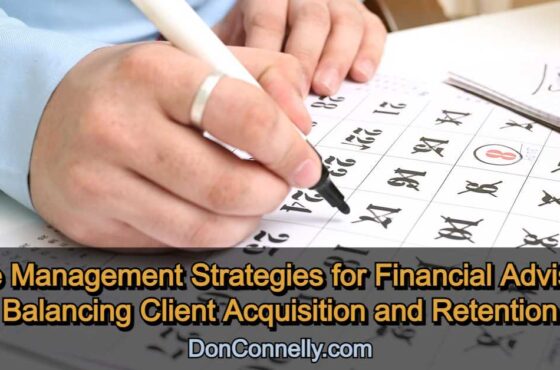Zoom Fatigue: 5 Steps Financial Advisors Can Take to Overcome It
 Living in a virtual world as we have for the last year and a half has had its benefits as well as its drawbacks. COVID-19 accelerated the adoption of technology that has helped financial advisors become more efficient and productive with greater outreach to clients and prospects. But it seems that advisors are reaching peak “Zoom fatigue,” an actual medical condition that can have a debilitating effect similar to depression. If you think you may be suffering from Zoom fatigue, you can make some simple adjustments to adapt to the conditions that cause it while enhancing your virtual presence.
Living in a virtual world as we have for the last year and a half has had its benefits as well as its drawbacks. COVID-19 accelerated the adoption of technology that has helped financial advisors become more efficient and productive with greater outreach to clients and prospects. But it seems that advisors are reaching peak “Zoom fatigue,” an actual medical condition that can have a debilitating effect similar to depression. If you think you may be suffering from Zoom fatigue, you can make some simple adjustments to adapt to the conditions that cause it while enhancing your virtual presence.
What exactly is Zoom fatigue?
Zoom fatigue is a real thing that can occur with the overuse of any video-conferencing platform. Symptoms include feeling tired, mentally drained, and overwhelmed caused by the need to be perpetually “on” while jumping from online meeting to online meeting. Several studies have found that increased screen time, coupled with more sedentary conditions, increases your chances of developing moderate to severe depression.
More specifically, constant virtual conferencing can take a mental toll in several ways:
Intense eye contact.
We don’t make nearly as much eye contact in the real world as we are often forced to do in a virtual meeting. In the virtual world, eye contact is necessary because it’s the only way we can demonstrate we’re paying attention. Having your eyes constantly riveted on others can feel demanding and even oppressive.
Watching yourself.
Something else we never have to do in the real world is to watch ourselves. Viewing yourself on screen is disconcerting because it brings your attention to how you look and how you’re performing and makes you wonder how others perceive you. It’s fatiguing because it messes with your brain.
Being sedentary.
In our traditional environment, we are able to walk around from meeting to meeting, visit colleagues, or just move around. The only movement we make in the virtual world is toggling between video conferences, which also affects our mental health.
Can’t see nonverbal cues.
Perhaps the most debilitating of all conditions is the inability to read the nonverbal cues of our clients and prospects. That’s how we collect vital information and feedback. The inability to interpret nonverbal cues adds to the stress of virtual meetings because we can only assume the subtext of a conversation without the verification of nonverbal cues.
Fighting off Zoom fatigue
Though many advisors are returning to their offices, virtual meetings have become the new normal and are here to stay. When used effectively, they have been shown to increase productivity, increase client satisfaction, and expand advisors’ reach. But Zoom fatigue is real, and in addition to causing mental health issues, it can lead to poor performance in virtual settings. Here are a few minor adjustments you can make to not only avoid Zoom fatigue but also enhance your virtual presence.
#1. Stop multitasking
We might think we are more productive when trying to multitask during virtual conferences, but we’re not. One study found that multitasking actually reduces performance by 40%. That includes trying to engage multiple types of media at the same time. It not only affects memory but also increases the difficulty of performing simple tasks.
#2. Stop looking at yourself
Watching yourself on a Zoom call only heightens your awareness of being watched by others, which can be distracting and induce anxiety. If you’re happy with your appearance and your background, turn off the self-view and focus on your call.
#3. Keep your meetings short
I saw a cartoon in the New Yorker which perfectly illustrates this point. It’s a man dressed in his PJs sitting at a table with his laptop, exclaiming with wide eyes, “My God…. Those meetings could have all been emails!”
Nobody wants to sit through long meetings, and lengthy virtual conferences can be more frustrating and exhausting than in-person meetings. Plan your meetings to be short and to the point. Send out an agenda of your call to help prepare your participants and ensure you stay on point.
#4. Don’t make virtual meetings your communications default
Don’t assume you need to communicate with your clients virtually. Your clients might find it refreshing to receive some meaningful, easy-to-read documents instead.
#5. Send one-way videos
One idea I saw could enhance your communications with clients and prospects. You can communicate an idea using a short, one-way video recorded for a specific client or prospect or your entire target market. It’s more personal than email and just as easy as making a phone call and leaving a message. Through websites like Dubb.com and BombBomb.com, you can make a short, three-minute video in just over three minutes.
We know that virtual is the new normal, so it’s essential to up your game and make the most out of it while eliminating the conditions that lead to Zoom fatigue.
Virtual or face-to-face meetings, either way you will need the know-how to beat the 80% failure rate in our business and we have the training program to help you with just that! Watch this 3-minute video to learn more.
See program details and enroll today!
24 videos, 24 exercises, 5 LIVE group coaching sessions (included only with the 12-week coaching program). An enormous advantage over your competition. Enroll now!



